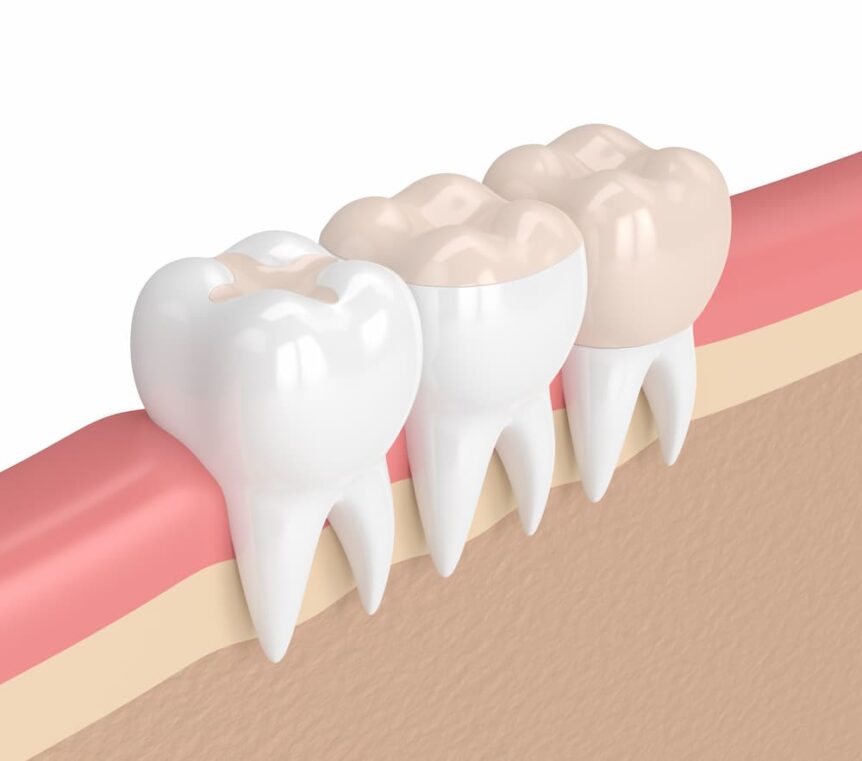Both inlays and onlays serve as more durable and aesthetic solutions over basic tooth fillings. But when is each type of restoration recommended? Let’s clarify the key differences.
Inlays fit within the grooves on the chewing surface of a damaged tooth, filling the space between cusps like pieces of a puzzle.
About the size of a traditional silver filling, they are well-suited to minor or moderate decay confined to the middle rather than the edges.
Porcelain, composite resin, and gold make for strong and color-matched inlay materials.
In comparison, onlays protect a larger portion of the tooth’s biting surface by covering at least one cusp. They wrap over the edges and help prevent further fracture.
Onlays are recommended for injuries or decay affecting multiple cusps, while still preserving healthy structure. Back teeth are common locations. If the damage to the tooth is too extensive, you will likely want to consider a dental crown, to replace the damaged tooth entirely.
Custom-fit onlays offer precision placement and longevity exceeding direct composite alternatives which can shrink over time.
Now that we’ve explored when inlays versus onlays are used, you may be curious what unique benefits these restorations offer over the fillings you’ve relied on previously. Stay tuned as we uncover meaningful advantages modern inlay and onlay technology provides—and how upgrading could positively shape your oral health journey moving forward.
Benefits Over Traditional Tooth Fillings
If you’ve had traditional dental fillings, you likely understand the frustrations of discomfort, poor aesthetics, and repeated repairs.
Modern inlays and onlays offer meaningful improvements. How so?
Firstly, custom-fit inlays and onlays better conserve healthy tooth structure through precision placement rather than drilling out large areas. The materials bond tightly with less aggressive tooth removal needed.
Secondly, durable porcelain or composite materials provide superior strength against fractures for 10-15 years versus just 3-10 with basic fillings.
Finally, tooth-colored materials like resin seamlessly match surrounding teeth without unsightly silver amalgam discolorations.
Upgrading from regular fillings brings you benefits like:
Preserving Natural Tooth Structure
Inlays and onlays take a conservative approach focused on preservation rather than fully replacing decayed sections.
Through detailed digital impressions and custom-milling, these restorations precisely fit the unique contours and grooves of your smile. Only damaged areas get removed while healthy structure stays protected.
The chosen material then locks into place through micro-mechanical bonding with the tooth. This tissue-saving accuracy avoids unnecessary drilling while reinforcing vulnerable spots.
Enhanced Durability and Aesthetics
The materials used for modern inlays and onlays prove far more durable than traditional fillings. Resilient porcelain and composite resin handle chewing forces over years of use without fracture or deterioration.
Expect a decade or longer before replacement is needed. Compare that to basic fillings needing repairs every few years.
Additionally, custom color-matching and polishing ensures inlays or onlays blend naturally with surrounding teeth for an improved look. No more unsightly silver spots.
Sensitivity and functionality also improve over traditional alternatives.
Modern inlays or onlays brings meaningful benefits from natural tissue preservation to long-lasting strength and flawless aesthetics allowing you to smile confidently.
Investing in these precision restorations protects your oral health using conservative, pain-free techniques for years to come.
You likely wonder what receiving these advanced restorations entails and how many visits are needed.
Not to worry! I’ll walk you through the placement process step-by-step so you know exactly what to expect.
The Step-by-Step Placement Process
Gone are the days of inconvenient impressions, temporary replacements, and waiting weeks for indirect restorations like inlays and onlays.
CEREC delivers a modern solution consolidating every step from diagnosis to permanent placement in one streamlined appointment.
How?
By leveraging advanced digital scanning, immediate in-office milling, and direct bonding, we can restore damaged teeth predictably and precisely with custom-fit restorations.
The process unfolds smoothly across a few integrated phases. Here is what you can expect when getting an inlay or onlay with our cutting-edge CEREC system:
Consultation
We begin by thoroughly assessing your oral health, carefully examining teeth, and accurately diagnosing any requiring restoration.
Once a treatment plan is formed, we discuss recommended options like an inlay or onlay.
When we’ve agreed on a treatment plan, our team will then gently numb the local area before cautiously removing decay and conservatively preparing the tooth’s structure.
Precision digital impressions neatly capture the fresh preparation in intricate detail.
Design and Milling
With extraordinarily detailed 3D scans in hand, we map out the planned restoration’s optimal contours and contacts to seamlessly integrate with surrounding anatomy.
This digital data then rapidly transfers to the integrated CEREC fabrication mill which expertly carves your permanent inlay or onlay from a porcelain block, exquisitely matched to your natural shade.
Within minutes, a magnificently crafted restoration materializes, ready for validation.
Fitting and Cementation
During try-in, we validate fit and contacts, ensuring the CEREC-milled inlay or onlay integrates superbly with your unique bite and smile.
Finally, an extraordinarily strong bonding resin cement durably adheres the polished porcelain restoration permanently to place in the prepared tooth structure.
And just like that, your restoration is complete!
CEREC ingeniously fuses multiple lengthy steps into one accelerated digitally-integrated workflow. This means treatment conveniently wrapped up in a single appointment without temporaries.
Our patients overwhelmingly appreciate the comfort, efficiency, and flawless precision of this advanced solution.
Caring for Your Restoration
With your new inlay or onlay in place, the journey continues toward protected oral health for over a decade to come.
But this longevity relies on diligent daily care along with routine professional maintenance. Don’t worry, we’re here as your guide every step of the way.
Arm yourself with these essential at-home tips after placement while routinely visiting Farnham Dentistry to nurture your restoration’s long-term success.
Post-Placement Care Essentials
In the days following placement, avoid exceptionally hard or sticky foods allowing full cement setting first. Crunchy, chewy items risk damaging the porcelain material.
Over the next weeks, slowly introduce firmer foods once healing progresses. Limit sugar intake which can lead to decay and undermine inlay and onlay edges.
Brush twice daily using gentle pressure with a soft-bristled brush and fluoride toothpaste. Regular flossing removes plaque buildup prone to occur at restoration margins and in-between teeth. Use additional cleaning aids like an oral irrigator to flush out lingering bacteria.
Call the office if you notice sensitivity or staining which may show an issue with the placement needing correction.
Most importantly, maintain biannual exams so we can confirm everything looks great while rapidly addressing early concerns.
Ensuring Long-Lasting Success
Achieving over ten years of reliable service from your inlay or onlay requires continuing thorough daily hygiene and routine professional care after placement.
Gently brush morning and night to lift debris without damaging durable porcelain or resin materials. Floss daily, cautiously navigating restoration edges where plaque readily hides. Use disclosing solution to highlight areas needing more careful attention.
Schedule examinations with our office every six months for professional cleaning, oral cancer screening, bite analysis, and early decay detection around restoration margins. While materials and bonding techniques aim for lifelong stability, occasional re-cementation or replacement proves necessary years later as aging occurs.
Contact our office if you ever notice poor marginal fit, hot/cold sensitivity, or discoloration indicating underlying issues need addressing promptly.
With diligent daily habits and professional care, your custom inlay or onlay serves you beautifully for years to come!
Ready to find out more? Contact us at Farnham Dentistry, and let’s discuss how these restorations can help you.

